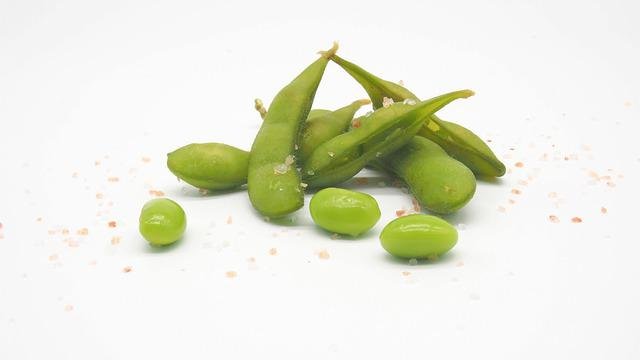
Edamame are a concentrate of goodness and health, principles of the oriental culinary tradition, not yet well known in the Mediterranean one. Let’s see their properties and how to introduce them into our diet.
Edamame are nothing more than soy beans, typical foods of Chinese and Japanese cuisine. Surely many of us have had the opportunity to taste them in Japanese restaurants, where they are served boiled still inside their pod, usually as an appetizer. More precisely, the name edamame refers to boiled soy pods.
The edamame plant has very ancient origins: first cultivated only in China, Japan and Korea, it then spread to Europe and the United States. Edamame are harvested while still unripe and boiled.
The main differences with dry soybeans are that edamame are green because they are unripe crops, larger in size, softer in texture and sweeter and more delicate in flavor than dry ones. But what are the nutritional properties of edamame? Let’s find out below.
Edamame: calories and nutritional properties
Edamame are therefore legumes and as such they retain all their nutritional qualities. They have a low calorie content, it is in fact 109 kcal per 100 g and an excellent protein content, equal to about 11 g per 100 g. They contain about 75% water and 8 g of carbohydrates per 100 g, most of which is fiber.
They also contain about 5 g of fats per 100 g, but they are mostly polyunsaturated fats of the omega 3 series, therefore “good” fats. Among the micronutrients we find many mineral salts, including sodium, potassium, iron, calcium, magnesium and vitamins, including C and K.
Nutritional values per 100g of edamame:
- Kcal: 109
- Carbohydrates: 7.61 g
- Proteins: 11.22 g
- Fat: 4.73 g
- Waterfall: 75.17 g
- Fibers: 4.8 g
- Soccer: 60 mg
- Iron: 2.11 mg
- Magnesium: 61 mg
- Potassium: 482 mg
- Sodium: 6 mg
- C vitamin: 9.7 mg
- Folate: 303 μg
- Vitamin K: 31.4 μg
Edamame: the health benefits
The properties of edamame beans are given by the high presence of vitamins and mineral salts, as well as proteins and fibers, all nutrients that give them numerous benefits for our health. In particular, they help the cardiovascular system by helping to lower cholesterol, contain vitamins and mineral salts that are important for bones, the circulatory system, the nervous system and are also great allies for physical fitness, even for those who want to lose weight. Now let’s see in detail all the benefits of edamame.
✓ Lower cholesterol
Thanks to the presence of isoflavones, antioxidant molecules, associated with the proteins that edamame beans contain, they counteract the effects of bad cholesterol helping to reduce it. The polyunsaturated fatty acids of the omega 6 and omega 3 series also improve the lipid profile by helping to lower blood cholesterol levels.
✓ Counteract hyperglycemia
The high fiber content in edamame makes these beans particularly suitable for those who need to keep their blood sugar under control.
✓ Allies of women
Green soybeans are rich in phytoestrogens, that is, plant-type estrogens, and in particular isoflavones, which behave very similarly to our hormones. During menopause, estrogen decreases physiologically in women and it appears that these phytoestrogens are able to maintain hormonal balance, helping to mitigate bothersome symptoms of menopause, such as hot flashes. Estrogen is also connected to the production of collagen, a molecule that maintains the elasticity of the skin, so it would also be helpful for the health of the skin, hair and nails.
✓ They prevent osteoporosis
The mineral salts contained in edamame (manganese, potassium, calcium, magnesium), together with vitamins and in particular vitamin K, help to maintain bone density and are therefore important for maintaining bone health and therefore in preventing osteoporosis.
✓ Promote fertility
Edamame are rich in folate, which is extremely useful in women of childbearing age and in pregnancy, as they help the development of the fetus.
✓ Promote a good mood
The folates present in edamame also have the effect of counteracting depression by acting on the levels of homocysteine produced by the body. An excess of plasma homocysteine has in fact been correlated with a greater risk of depression, as well as cardiovascular disease.
✓ Antioxidant and anti-inflammatory properties
Edamame are rich in choline, an essential molecule for our body, which has various functions and has antioxidant and protective properties on cells.
✓ Useful in the prevention of prostate cancer
It has been shown that the polyphenols contained in different plant species are able to modulate the response of cells to DNA damage, often responsible for the genesis of cancer. In particular, isoflavones have an important role in the prevention of prostate cancer thanks to their anti-inflammatory effect.
Edamame: how many to eat
An average portion of edamame soy corresponds to about 100 g and with this daily quantity you can fully benefit from its nutritional qualities. It is advisable to use them as a substitute for other legumes, possibly alternating them in the diet. In addition, they are gluten-free and can also be consumed by celiacs.
Edamame: how to use them in the kitchen
The flavor of edamame is quite delicate, with sweet notes similar to peas and an aftertaste that can remind of hazelnut. Given their flavor and their excellent nutritional values, these Japanese beans lend themselves very well to various types of diets: they are excellent for children for their sweet taste, for pregnant women for the generous supply of folate, for the elderly for their content of proteins, vitamins and minerals, for those who want to control their weight with a low-calorie diet.
Although they are legumes, which in general are contraindicated in case of hyperuricemia, these beans instead have a low content of purines and can therefore be included in the diet of a person suffering from hyperuricemia. They are also suitable for celiacs and are a good complement of proteins for those who choose a vegetarian or vegan diet.
As already mentioned, edamame are usually served as an appetizer, boiled or steamed and still in their pods in oriental restaurants, so even at home we can prepare them this way.
It is possible to find them fresh in ethnic or macrobiotic food stores but it is much easier to find them in supermarkets in the frozen version at affordable prices and we can certainly buy them because even when frozen they retain all their nutritional qualities.
If we take them frozen, just blanch them in boiling water for a few minutes or put them in the microwave, the important thing is that they keep their crunchiness. After that, they can be consumed by adding them to salads or to make cold first courses together with cereals such as rice, barley, quinoa, spelled or together with pasta.
In winter we can add them to our hot soups or use them to prepare tasty meatballs or vegetable burgers. They are also very good lightly passed in oil with the addition of the spices we like best.
Contraindications of edamame
If consumed in moderate quantities there are no major contraindications to the use of edamame beans. An abuse of this food is instead harmful for pregnant women and for those suffering from kidney diseases given the high content of oxalates.
Even those with breast cancer or undergoing chemotherapy should avoid edamame due to its phytoestrogen content which may interfere with therapy. Obviously the intake of edamame is forbidden for those allergic to soy.
Edamame: price and where to buy them
Edamame soybeans can be found in organic supermarkets, generally in the legume department and are mostly found in glass jars or cans. If you suffer from nickel allergy it is advisable to choose glass packaging. In addition, there are fresh edamame soybean pods on the market, which are generally found in the frozen food department. Alternatively, it is possible to find edamame, in its various forms, also online in specialized stores.






